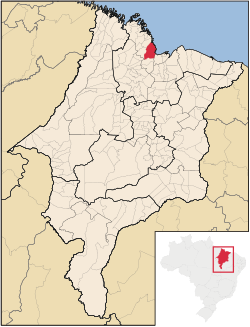Top Qs
Timeline
Chat
Perspective
Alcântara Space Center
Brazilian Space Center From Wikipedia, the free encyclopedia
Remove ads
The Alcântara Space Center (Portuguese: Centro Espacial de Alcântara, CEA), former known as Alcântara Launch Center (Portuguese: Centro de Lançamento de Alcântara,[3]) is a space center and launching facility of the Brazilian Space Agency in the city of Alcântara, located on Brazil's northern Atlantic coast, in the state of Maranhão.[4] It is operated by the Brazilian Air Force (Comando da Aeronáutica). The CEA is the closest launching base to the equator. This gives the launch site a significant advantage in launching geosynchronous satellites, an attribute shared by the Guiana Space Centre.
Due to its location, it is well-positioned for geosynchronous launch. As such, several agencies and companies have studied or signed agreements to launch from Alcântara, including Ukraine's Tsyklon-4,[5] Israel's Shavit,[6] Russia's Proton,[7] Virgin Orbit's LauncherOne[8][9] and Innospace's Hanbit-Nano.
Construction of the base began in 1982. The first launch occurred on February 21, 1990, when the sounding rocket Sonda 2 XV-53 was launched.[10] On August 22, 2003, the explosion of the third VLS-1 (XV-03) killed 21 people.[11]
Remove ads
Construction
Construction of the Alcântara Space Center began in 1982, as the Brazilian Space Agency's existing rocket range at Barreira do Inferno Launch Center was being overtaxed by growing demand for launch capacity.[12] In 2020, the government of Brazil announced their plan to expand the base by more than 12,000 hectares.[13]
Controversies
The construction of the space center was controversial, as the site for the center was located on several quilombos, settlements inhabited largely by descendants of escaped slaves in Brazil. In 1980, Brazil's military government forcibly relocated more than 300 families to inland villages away from the coast to make way for the center. This heavily disrupted their traditional livelihood of fishing and led to multiple cases of malnutrition among the residents.[14]
Human rights concerns over the displacement of locals were reported on during the center's planned expansions in 2001[14] and 2021, with residents and activists lobbying the government to halt expansions to prevent more communities from being displaced.[13] In 2023, the Brazilian government issued a public apology to the quilombolas and offered reparations.[15]
Remove ads
Public-private partnership
Companies based in Alcântara as of 2021, with the objective of orbital and sub-orbital launches, for commercial purposes or in partnership with the Brazilian government:[16][17]
As of August 2021, the Brazilian government established Ordinance No. 698, a regulation that follows the FAA 14 CFR part 450 standard, which deals with launch and re-entry licenses in order to follow the world standard in space activities.[19]
Agreement between Brazil and the U.S.
In 2019, Brazil and the U.S. signed an agreement, with the objective of preventing unauthorized access or transfer of U.S. technologies related to the launches from Alcântara.[20]
Remove ads
Structures
- Engine preparation facilities (Preparação de Propulsores - PPP)
- Payload preparation facilities (Preparação de Carga Útil - PPCU)
- Liquid-fuel loading facilities (Preparação de Carregamento de Propelentes - PCPL)
- Universal launch tower
- Mobile Integration Tower (TMI - Torre Móvel de Integração): 33m × 10m × 13m, 380 metric tons. Used for VLS rocket assembly.
- Control center (Prédio de Controle Avançado - CASAMATA).
- 2600m runway
List of launchpads
The Alcântara launch pads include:
- VLS Pad (with Mobile Integration Tower - TMI) 02.31770°S 44.36779°W
- MRL Pad (general sounding rocket pad) 02.31608°S 44.36730°W
- "Universal" pad for rockets up to 10 tons 02.31599°S 44.36782°W
- A newly built pad to support Innospace's launches 02.31698°S 44.36873°W
Remove ads
Launch list
Summarize
Perspective
The list of flights conducted and planned from Alcântara:
Alcântara Space Center (from 2021)
Alcântara Launch Center (1982-2022)
Remove ads
See also
- Aerospace Operations Command Brazilian space command
- Rocket Launch Sites Worldwide
References
External links
Wikiwand - on
Seamless Wikipedia browsing. On steroids.
Remove ads






